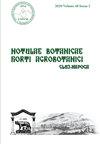硒通过提高八角作物的光合作用效率、细胞完整性、渗透保护剂和油脂含量来改善灌溉不足的影响
IF 1.3
4区 生物学
Q3 PLANT SCIENCES
引用次数: 0
摘要
八角是具有治疗潜力的植物之一,被列为具有有趣生物效应的最重要药用植物之一。其成分可被视为抗生素的 "天然 "和 "安全 "替代品,并被应用于食品和化妆品等不同行业。硒(Se)是一种重要的微量营养元素,但尚未充分研究硒对提高茴香油产量和质量的重要性,特别是在干旱条件下。因此,我们连续两季研究了干旱胁迫下叶面施肥对八角植物的影响。硒以三种不同的浓度(0.0、1.0 和 2.0 毫摩尔,分别称为 Se0、Se1 和 Se2)与两种水平的作物蒸散量(ET)一起施用:全灌溉、100% 蒸散发(FI)和 60% 蒸散发(DI)。DI × Se1 或 Se2(对第一季的 Fv/Fm、RWC% 和 MSI%)和 DI × Se2(对第二季的 Fv/Fm 和 MSI%)组合的促进作用与 FI × Se2 相似。与对应的对照处理(DI × Se0)相比,两季施用 DI × Se2 的游离氨基酸总量(31.5% 和 31.6%)、可溶性糖总量(84.2% 和 86.4%)和游离脯氨酸含量(84.2% 和 86.4%)分别增加最多。在 DI 条件下,Se2 在第二季记录到最大的根长、芽鲜重和芽干重值。在干旱条件下,施用 Se1 和 Se2 后,第一季种子产量分别增加了 1.72 倍和 1.62 倍,第二季分别增加了 1.50 倍和 1.43 倍。两季中提高 IWUE 最有效的方法是 Se1× DI,其次是 Se2× DI。根据色谱检测,FI × Se2 的茴香醚含量最高,而 DI × Se2 的芳樟醇含量大幅增加。总之,建议干旱和半干旱地区的种植者在八角施肥时使用硒(2.0 mM),以减轻干旱的不利影响,保持作物的产量和质量。本文章由计算机程序翻译,如有差异,请以英文原文为准。
Significance of selenium in ameliorating the effects of irrigation deficit via improving photosynthesis efficiency, cell integrity, osmo-protectants, and oil profile of anise crop
Anise is one of the plants with therapeutic potential, which is classified among the most important medicinal plants with interesting biological effects. Its components could be perceived so as “natural” and “safe” alternatives to antibiotics as well as they are applied in different industries such as food and cosmetic purposes. Selenium (Se) is an essential micronutrient, however, its importance to improve oil yield and quality of anise has not been adequately investigated, specifically under drought. Therefore, two successive seasons were conducted to investigate the effect of selenium foliar application upon anise plants under drought stress. Selenium was applied at three different concentrations (0.0 1.0 and 2.0 mM denoted Se0, Se1 and Se2, respectively) along with two levels of crop evapotranspiration (ET): Full irrigation, 100% of ET (FI) and 60% of ET (DI). The promotive effect of combinations of DI × Se1 or Se2 (for Fv/Fm, RWC%, and MSI% in the first season) and DI × Se2 (for Fv/Fm, and MSI% in the second season) were as similar as FI × Se2. Compared to the counterpart control treatment (DI × Se0), the highest increases in total free amino acids (31.5 and 31.6%), total soluble sugars (84.2 and 86.4%) and free proline content (84.2 and 86.4%) were recorded with application of DI × Se2 practice in both seasons, respectively. Under DI, Se2 recorded the maximum values of root length, shoot fresh weight and shoot dry weight in the second season. Under drought, the increases in seed yield due to application of Se1 and Se2 amounted to 1.72 and 1.62 folds in the 1st season and 1.50 and 1.43 folds in 2nd one, respectively. The most effective practice for improving IWUE was Se1× DI in both seasons, followed by Se2 × DI. Based on the chromatographical detection, the maximum values of Anethole were recorded with FI × Se2 while L-Linalool has greatly increased with DI × Se2. In conclusion, the growers in arid and semi-arid zones are advised to use selenium (2.0 mM) in anise fertilization to mitigate the adverse impacts of drought, and keeping crop yield and quality.
求助全文
通过发布文献求助,成功后即可免费获取论文全文。
去求助
来源期刊

Notulae Botanicae Horti Agrobotanici Cluj-napoca
PLANT SCIENCES-
CiteScore
2.70
自引率
0.00%
发文量
118
审稿时长
3 months
期刊介绍:
Notulae Botanicae Horti Agrobotanici Cluj-Napoca is a peer-reviewed biannual journal aimed at disseminating significant research and original papers, critical reviews and short reviews. The subjects refer on plant biodiversity, genetics and plant breeding, development of new methodologies that can be of interest to a wide audience of plant scientists in all areas of plant biology, agriculture, horticulture and forestry. The journal encourages authors to frame their research questions and discuss their results in terms of the major questions of plant sciences, thereby maximizing the impact and value of their research, and thus in favor of spreading their studies outcome. The papers must be of potential interest to a significant number of scientists and, if specific to a local situation, must be relevant to a wide body of knowledge in life sciences. Articles should make a significant contribution to the advancement of knowledge or toward a better understanding of existing biological and agricultural concepts. An international Editorial Board advises the journal. The total content of the journal may be used for educational, non-profit purposes without regard to copyright. The distribution of the material is encouraged with the condition that the authors and the source (Notulae Botanicae Horti Agrobotanici Cluj-Napoca or JCR abbrev. title Not Bot Horti Agrobo) are mentioned.
 求助内容:
求助内容: 应助结果提醒方式:
应助结果提醒方式:


